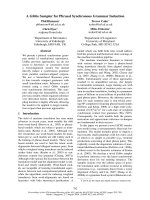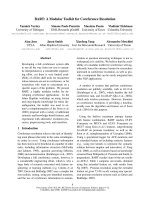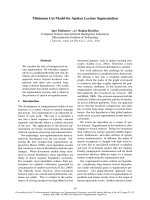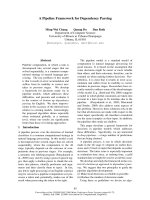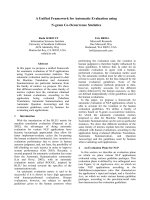Báo cáo khoa học: "A Morphographemic Model for Error Correction Nonconcatenative Strings" pot
Bạn đang xem bản rút gọn của tài liệu. Xem và tải ngay bản đầy đủ của tài liệu tại đây (511.39 KB, 7 trang )
A Morphographemic Model for Error Correction in
Nonconcatenative Strings
Tanya Bowden * and George Anton Kiraz t
University of Cambridge
Computer Laboratory
Pembroke Street, Cambridge CB2 3QG
{Tanya. Bowden, George.Kiraz}@cl. cam. ac. uk
http://www, cl. cam. ac .uk/users/{tgblO00, gkl05}
Abstract •
This paper introduces a spelling correction
system which integrates
seamlessly
with
morphological analysis using a multi-tape
formalism. Handling of various Semitic er-
ror problems is illustrated, with reference
to Arabic and Syriac examples. The model
handles errors vocalisation, diacritics, pho-
netic syncopation and morphographemic
idiosyncrasies, in addition to Damerau er-
rors. A complementary correction strategy
for morphologically sound but morphosyn-
tactically ill-formed words is outlined.
1 Introduction
Semitic is known amongst computational linguists,
in particular computational morphologists, for its
highly inflexional morphology. Its root-and-pattern
phenomenon not only poses difficulties for a mor-
phological system, but also makes error detection
a difficult task. This paper aims at presenting a
morphographemic model which can cope with both
issues.
The following convention has been adopted. Mor-
phemes are represented in braces, { }, surface
(phonological) forms in solidi, //, and orthographic
strings in acute brackets, (). In examples of gram-
mars, variables begin with a capital letter. Cs de-
note consonants, Vs denote vowels and a bar denotes
complement. An asterisk, *, indicates ill-formed
strings.
The difficulties in morphological analysis and er-
ror detection in Semitic arise from the following
facts:
* Supported by a British Telecom Scholarship, ad-
ministered by the Cambridge Commonwealth Trust in
conjunction with the Foreign sad Commonwealth Office.
t Supported by a Benefactor Studentship from St
John's College.
Non-Linearity A Semitic stem consists of a
root and a vowel melody, arranged accord-
ing to a canonical pattern. For example,
Arabic/kuttib/ 'caused to write - perfect pas-
sive' is composed from the root morpheme
{ktb} 'notion of writing' and the vowel melody
morpheme {ul} 'perfect passive'; the two are
arranged according to the pattern morpheme
{CVCCVC} 'causative'. This phenomenon is
analysed by (McCarthy, 1981) along the fines
of autosegmental phonology (Goldsmith, 1976).
The analysis appears in (1). 1
(1)
DERIVATION OF /kuttib/
u i
I I
/kuttib/ C V C C V C
a v i
k t b
• Vocalisation Orthographically, Semitic texts
appear in three forms: (i) consonantal texts
do not incorporate any short vowels but
ma-
ttes lectionis, 2
e.g. Arabic (ktb) for /katab/,
/kutib/and/kutub/, but (kaatb) for/kaatab/
and /kaatib/; (ii) partially voealised texts
incorporate some short vowels to clarify am-
biguity, e.g. (kutb) for /kutib/ to distinguish
it from /katab/; and (iii) voealised texts in-
corporate full vocalisation, e.g. (tadahra]) for
/tada ay.
1We have used the CV model to describe pattern mor-
phemes instead of prosodic terms because of its familiar-
ity in the computational linguistics literature. For the
use of moraic sad affLxational models in handling Arabic
morphology computationally, see (Kiraz,).
2'Mothers of reading', these are consonantal letters
which play the role of long vowels, sad are represented
in the pattern morpheme by VV (e.g.
/aa/,
/uu/,
/ii/).
Mattes lectionis
cannot be omitted from the or-
thographic string.
24
• Vowel and Diacritic Shifts Semitic lan-
guages employ a large number of diacritics to
represent
enter alia
short vowels, doubled let-
ters, and nunation. 3 Most editors allow the user
to enter such diacritics above and below letters.
To speed data entry, the user usually enters the
base characters (say a paragraph) and then goes
back and enters the diacritics. A common mis-
take is to place the cursor one extra position
to the left when entering diacritics. This re-
sults in the vowels being shifted one position,
e.g. *(wkatubi) instead of (wakutib).
• Vocalisms The quality of the perfect and im-
perfect vowels of the basic forms of the Semitic
verbs are idiosyncratic. For example, the Syr-
iac root {ktb} takes the perfect vowel a, e.g.
/ktab/, while the root {nht} takes the vowel e,
e.g. /nhet/. It is common among learners to
make mistakes such as */kteb/or */nhat/.
• Phonetic Syncopation A consonantal seg-
ment may be omitted from the
phonetic
surface
form, but maintained in the
orthographic sur-
face from. For example, Syriac (md/nt~)'city' is
pronounced/mdit~/.
* Idiosyncrasies The application of a mor-
phographemic rule may have constraints as on
which lexical morphemes it may or may not ap-
ply. For example, the glottal stop [~] at the end
of a stem may become [w] when followed by the
relative adjective morpheme {iyy}, as in Arabic
/samaaP+iyy/-+/samaawiyy/'heavenly', but
/hawaaP+iyy/-~/hawaa~iyy/'of air'.
* Morphosyntactic Issues In broken plurals,
diminutives and deverbal nouns, the user may
enter a morphologically sound, but morphosyn-
tactically ill-formed word. We shall discuss this
in more detail in section 4. 4
To the above, one adds language-independent issues
in spell checking such as the four Damerau trans-
formations: omission, insertion, transposition and
substitution (Damerau, 1964).
2 A Morphographemic Model
This section presents a morphographemic model
which handles error detection in non-linear strings.
3When indefinite, nouns and adjectives end in a
pho-
netic
In] which is represented in the
orthographic
form
by special diacritics.
4For other issues with respect to syntactic dependen-
cies, see (Abduh, 1990).
Subsection 2.1 presents the formalism used, and sub-
section 2.2 describes the model.
2.1 The Formalism
In order to handle the non-linear phenomenon of
Arabic, our model adopts the two-level formalism
presented by (Pulman and Hepple, 1993), with the
multi tape extensions in (Kiraz, 1994). Their for-
realism appears in (2).
(2)
TwO-LEVEL FORMALISM
LLC - LEX RLC
LSC -
SURF
- RSC
where
LLC
LEX
RLC
LSC
SURF
RSC
= left lexical context
= lexical form
= right lexical context
= left surface context
= surface form
= right surface context
The special symbol * is a wildcard matching any con-
text, with no length restrictions. The operator
caters for obligatory rules. A lexical string maps to
a surface string if[ they can be partitioned into pairs
of lexical-surface subsequences, where each pair is
licenced by a =~ or ~ rule, and no partition violates
a ¢~ rule. In the multi-tape version, lexical expres-
sions (i.e. LLC, LEX and RLC) are n-tuple of regu-
lax expressions of the form (xl, x2, , xn): the/th
expression refers to symbols on the ith tape; a nill
slot is indicated by ~.5 Another extension is giving
LLC the ability to contain ellipsis, , which in-
dicates the (optional) omission from LLC of tuples,
provided that the tuples to the left of are the first
to appear on the left of LEx.
In our morphographemic model, we add a similar
formalism for expressing error rules (3).
(3)
ERROR FORMALISM
ErrSurf =~ Surf
{ PLC- PRC } where
PLC = partition left context
(has been done)
PRC = partition right context
(yet to be done)
5Our implementation interprets rules directly; hence,
we allow ~. If the rules were to be compiled into au-
tomata, a genuine symbol, e.g. 0, must be used. For the
compilation of our formalism into automata, see (Kiraz
and Grimley-Evans, 1995).
25
The error rules capture the correspondence be-
tween the error surface and the correct surface, given
the surrounding partition into surface and lexical
contexts. They happily utilise the multi-tape format
and integrate seamlessly into morphological analy-
sis. PLC and PRC above are the left and right con-
texts of both the lexical and (correct) surface levels.
Only the =~ is used (error is not obligatory).
2.2 The Model
2.2.1 Finding the error
Morphological analysis is first called with the as-
sumption that the word is free of errors. If this fails,
analysis is attempted again without the 'no error' re-
striction. The error rules are then considered when
ordinary morphological rules
fail. If
no error rules
succeed, or lead to a successful partition of the word,
analysis backtracks to try the error rules at succes-
sively earlier points in the word.
For purposes of simplicity and because oh the
whole is it likely that words will contain no more
than one error (Damerau, 1964; Pollock and Zamora,
1983), normal 'no error' analysis usually resumes if
an error rule succeeds. The exception occurs with a
vowel shift error (§3.2.1). If this error rule succeeds,
an expectation of further shifted vowels is set up,
but no other error rule is allowed in the subsequent
partitions. For this reason rules are marked as to
whether they can occur more than once.
2.2.2
Suggesting a correction
Once an error rule is selected, the corrected sur-
face is substituted for the error surface, and nor-
mai analysis continues - at the same position. The
substituted surface may be in the form of a vari-
able, which is then ground by the normal analysis
sequence of lexical matching over the lexicon tree.
In this way only lexical words a~e considered, as
the variable letter can only he instantiated to letters
branching out from the current position on the lexi-
con tree. Normal prolog backtracking to explore al-
ternative rules/lexical branches applies throughout.
3 Error Checking in Arabic
We demonstrate our model on the Arabic verbal
stems shown in (4) (McCarthy, 1981). Verbs are
classified according to their measure (M): there
are 15 trilateral measures and 4 quadrilateral ones.
Moving horizontally across the table, one notices a
change in vowel melody (active {a}, passive {ui});
everything else remains invariant. Moving vertically,
a change in canonical pattern occurs; everything else
remains invariant.
Subsection 3.1 presents a simple two-level gram-
mar which describes the above data. Subsection 3.2
presents error checking.
(4)
ARABIC VERBAL STEMS
Measure Active Passive
1 katab kutib
2 kattab kuttib
3 kaatab kuutib
4 ~aktab ~uktib
5 takattab tukuttib
6 takaatab tukuutib
7 nkatab nkutib
8 ktatab ktutib
9 ktabab
10 staktab stuktib
11 ktaabab
12 ktawtab
13 ktawwab
14 ktanbab
15 ktanbay
Q1 dahraj duhrij
Q2 tadahraj tuduhrij
Q3 dhanraj dhunrij
Q4 dl~arjaj dhurjij
3.1
Two-Level Rules
The lexicai level maintains three lexieai tapes (Kay,
1987; Kiraz, 1994): pattern tape, root tape and vo-
calism tape; each tape scans a lexical tree. Exam-
pies of pattern morphemes are: (ClVlC2VlC3} (M 1),
{ClC2VlnC3v2c4} (M
Q3). The root morphemes are
{ktb} and {db_rj}, and the vocalism morphemes are
{a} (active) and {ui} (passive).
The following two-level grammar handles the
above data. Each lexical expression is a triple; lex-
ical expressions with one symbol assume e on the
remaining positions.
(5)
GENERAL RULES
* X - *
::~
R0: , _ X - *
* - (Pc, C,~) - *
=~
RI: . _ C - *
*
- (P~,~,V)
* =~
R2: , _ V *
where Pc E {Cl, c2, c3, c4},
P~ E {vl, v2},
26
(5) gives three general rules: R0 allows any char-
acter on the first lexical tape to surface, e.g. in-
fixes, prefixes and suffixes. R1 states that any P E
{Cl, c2, c3, c4} on the first (pattern) tape and C
on the second (root) tape with no transition on the
third (vocalism) tape corresponds to C on the sur-
face tape; this rule sanctions consonants. Similarly,
tL2 states that any P E {Vl, v2} on the pattern tape
and V on vocalism tape with no transition on the
root tape corresponds to V on the surface tape; this
rule sanctions vowels.
(6)
BOUNDARY RULES
R3: (B,e,~) - + - * =~
• - 6 - *
R4: (B,*,*) (+,+,+) - *
==~
where B ~ +
(6) gives two boundary rules: R3 is used for non-
stem morphemes, e.g. prefixes and suffixes. R4 ap-
plies to stem morphemes reading three boundary
symbols simultaneously; this marks the end of a
stem. Notice that LLC ensures that the right bound-
ary rule is invoked at the right time.
Before embarking on the rest of the rules, an il-
lustrated example seems in order. The derivation
of/dhunrija/(M Q5, passive), from the three mor-
phemes
{ClC2VlnCsv2c4} ,
{dhrj} and {ui}, and the
suffix {a} '3rd person' is illustrated in (7).
(7)
DERIVATION
OF M Q3 + {a}
u[ i [ +
vocalisrn tape
c2 vxlnlc3 v21c4 a[+
pattern tape
1120121403
IdlhlulnlrlilJl lal
Isurfacetape
The numbers between the surface tape and the
lexical tapes indicate the rules which sanction the
moves.
(s)
SPREADING RULES
R5: (P1, C, s) P *
• C *
=:~
R6: (Vl, 6, V) Vl " *
• V - *
=:~
where P1 e {c2, c3, c4}
Resuming the description of the grammar, (8)
presents spreading rules. Notice the use of ellipsis
to indicate that there can be tuples separating LEX
and LLC, as far as the tuples in LLC are the nearest
ones to LEX. R5 sanctions the spreading (and gem-
ination) of consonants. R6 sanctions the spreading
of the first vowel. Spreading examples appear in (9).
(9)
DERIVATION OF M 1- M 3
a. /katab/=
a[ +]VT
Cl vile2
vllc3 +
PT
121614
Ik]a[t[a]b[
IST
a I +]VT
b.
/kattab/ = cx VllC2
c21vllc3
+
PT
1215614
[klaltltlalb [
]ST
k t b RT
c. /kaatab/= cl vl[vl[c2 v1[c3
PT
1261614
[k[ala[t[alb[ [ST
The following rules allow for the different possible
orthographic vocalisations in Semitic texts:
R7 (V, - (v,
(V, e,
* . g *
R8 (Pcl, CI, e) (P, e, V) (Pc2, C2, e) =~
R9 A (vl,e,e) p =~
where A = (V1,6,V) "(Pc1,Cl,e) and p = (Pc2,C2,e).
R7 and R8 allow the optional deletion of short
vowels in non-stem and stem morphemes, respec-
tively; note that the lexical contexts make sure that
long vowels are not deleted. R9 allows the optional
deletion of a short vowel what is the cause of spread-
ing.
For example the rules sanction both /katab/
(M 1, active) and /kutib/ (M 1, passive) as inter-
pretations of (ktb) as showin in (10).
3.2 Error Rules
Below are outlined error rules resulting from pecu-
liarly Semitic problems. Error rules can also be con-
structed in a similar vein to deal with typographical
Damerau error (which also take care of the issue of
27
wrong vocalisms).
(lO)
TwO-LEVEL DERIVATION OF M 1
a.
kl
tJ bl
RT
/katab/=lctlvllc~lvllc31 PT
181914
Ikl Itl Ibl ]ST
ul i]
+IVT
b. /kutib/= cl v11c2 v11c3 + PT
181914
Ikl Itl Ibl
IST
3.2.1 Vowel ShiR
A vowel shift error rule will be tried with a parti-
tion on a (short) vowel which is not an expected (lex-
ical) vowel at that position. Short vowels can legiti-
mately be omitted from an orthographic representa-
tion - it is this fact which contributes to the problem
of vowel shifts. A vowel is considered shifted if the
same vowel has been omitted earlier in the word.
The rule deletes the vowel from the surface. Hence
in the next pass of (normal) analysis, the partition
is analysed as a legitimate omission of the
expected
vowel. This prepares for the next shifted vowel to
be treated in exactly the same way as the first. The
expectation of this reapplieation is allowed for in
reap = y.
(11)
E0:
X =~ e where reap = y
( [om_stmv,e,(*,*,X)] * }
El:
X ::~ e
where
reap=y
{ [*,*,(vl,~,X)] [om_sprv,6,(*,*,6)] * }
In the rules above, 'X' is the shifted vowel. It is
deleted from the surface. The partition contextual
tuples consist of [RULE NAME, SURF, LEX]. The
LEX element is a tuple itself of [PATTERN, ROOT,
VOCALISM].
In E0 the shifted vowel was analysed
earlier as an omitted stem vowel (ore_stray), whereas
in E1 it was analysed earlier as an omitted spread
vowel (om_sprv). The surface/lexical restrictions in
the contexts could be written out in more detail, but
both rules make use of the fact that those contexts
are analysed by other partitions, which check that
they meet the conditions for an omitted stem vowel
or omitted spread vowel.
For example, *(dhruji) will be interpreted as
(duhrij). The 'E0's on the rule number line indicate
where the vowel shift rule was applied to replace an
error surface vowel with 6. The error surface vowels
are written in italics.
(12)
TwO-LEVEL ANALYSIS OF
*(dhruji)
I u] i I
+IVT
I
d[ hlr[ j[
+[RT
ICllVllC lC3} lv lc, I I+lPT
1 8 1
1E08 1E04
[d]
Ihlr]ul
[Jlil
[ST
3.2.2 Deleted Consonant
Problems resulting from phonetic syncopation can
be treated as accidental omission of a consonant,
e.g. *(mdit~), (mdint~).
(13)
E2:6 =~ X where cons(X),reap = n
{,-,}
3.2.3 Deleted Long Vowel
Although the error probably results from a differ-
ent fault, a deleted long vowel can be treated in the
same way as a deleted consonant. With current tran-
scription practice, long vowels are commonly written
as two characters - they are possibly better repre-
sented as a single, distinct character.
(14)
E3: e =~
XX where vowel(X),reap = n
(,-,}
The
form *(tuktib) can be interpreted as either
(tukuttib) with a deleted consonant (geminated 't')
or (tukuutib) with a deleted long vowel.
(15)
Two-LEVEL
ANALYSIS OF
*(tuktib)
I nil I i, I+iVT
k t b+ RT
a. M 5 = t ]vllcl v11c2 Ic~1v21c3 +
PT
0 2 1 9 1E21 2 1 4
Itlulkl Itl Itlilbl
IST
b. M6=
ul il +IvT
k
Ivll c1[I t b +1RT
t Vl vt c21v2 c3 +1PT
0 2 1E36 6 12 14
Itlulk] lulultli[bl IST
28
3.2.4 Substituted Consonant
One type of morphographemic error is that conso-
nant substitution may not take place before append-
ing a suffix. For example/samaaP/'heaven' + {iyy)
'relative adjective' surfaces as (samaawiyy), where
P-~ w in the given context. A common mistake is to
write it as *(samma~iyy).
(16)
F_A: P ::~ w where reap = n
{ *- /glottal_change, w,(Pc,P,~)] }
The 'glottal_change' rule would be a normal mor-
phological spelling change rule, incorporating con-
textual constraints (e.g. for the morpheme bound-
ary) as necessary.
4 Broken Plurals, Diminutive and
Deverbal Nouns
This section deals with morphosyntactic errors
which are independent of the two-level analy-
sis. The data described below was obtained from
Daniel Ponsford (personal communication), based
on (Wehr, 1971).
Recall that a Semitic stems consists of a root mor-
pheme and a vocalism morpheme arranged accord-
ing to a canonical pattern morpheme. As each root
does not occur in all vocalisms and patterns, each
lexical entry is associated with a feature structure
which indicates
inter alia
the possible patterns and
vocalisms for a particular root. Consider the nomi-
nal data in (17).
(17)
BROKEN PLURALS
Singular Plural Forms
kadi~ kud~, *kidaa~
kaafil kuffal, *kufalaa~, *kuffaal
kaffil kufalaaP
sahm *Pashaam, suhuum, Pashum
Patterns marked with * are morphologically plausi-
ble, but do not occur lexically with the cited nouns.
A common mistake is to choose the wrong pattern.
In such a case, the two-level model succeeds in
finding two-level analyses of the word in question,
but fails when parsing the word morphosyntacti-
cally: at this stage, the parser is passed a root, vo-
calism and pattern whose feature structures do not
unify.
Usually this feature-clash situation creates the
problem of which constituent to give preference to
(Langer, 1990). Here the vocalism indicates the in-
flection (e.g. broken plural) and the preferance of
vocalism pattern for that type of inflection belongs
to the root. For example *(kidaa~)would be anal-
ysed as root {kd~} with a broken plural vocalism.
The pattern type of the vocalism clashes with the
broken plural pattern that the root expects. To cor-
rect, the morphological analyser is executed in gen-
eration mode to generate the broken plural form of
{kd~} in the normal way.
The same procedure can be applied on diminutive
and deverbal nouns.
5 Conclusion
The model presented corrects errors resulting from
combining nonconcatenative strings as well as more
standard morphological or spelling errors. It cov-
ers Semitic errors relating to vocalisation, diacrit-
ics, phonetic syncopation and morphographemic id-
iosyncrasies. Morphosyntactic issues of broken plu-
rals, diminutives and deverbal nouns can be handled
by a complementary correction strategy which also
depends on morphological analysis.
Other than the economic factor, an important ad-
vantage of combining morphological analysis and er-
ror detection/correction is the way the lexical tree
associated with the analysis can be used to deter-
mine correction possibilities. The morphological
analysis proceeds by selecting rules that hypothesise
lexical strings for a given surface string. The rules
are accepted/rejected by checking that the lexical
string(s) can extend along the lexical tree(s) from
the current position(s). Variables introduced by er-
ror rules into the surface string are then instantiated
by associating surface with lexical, and matching
lexical strings to the lexicon tree(s). The system is
unable to consider correction characters that would
be lexical impossibilities.
Acknowledgements
The authors would like to thank their supervisor
Dr Stephen Pulman. Thanks to Daniel Ponsford for
providing data on the broken plural and Nuha Adly
Atteya for discussing Arabic examples.
References
Abduh, D. (1990).
.suqf~bat tadqfq Pal-PimlSP
PSliyyan fi Pal-qarabiyyah
[Difficulties in auto-
matic spell checking of Arabic].
In Proceedings
of the Second Cambridge Conference: Bilingual
Computing in Arabic and English. In
Arabic.
Damerau, F. (1964). A technique for computer de-
tection and correction of spelling errors.
Comm.
of the Assoc. for Computing Machinery,
7(3):171-
6.
29
Goldsmith, J. (1976). Autosegmental Phonology.
PhD thesis, MIT. Published as Autosegmental
and Metrical Phonology, Oxford 1990.
Kay, M. (1987). Nonconcatenative finite-state mor-
phology. In Proceedings of the Third Conference
of the European Chapter o`f the Association for
Computational Linguistics, pages 2-10.
Kiraz, G. Computational analyses of Arabic mor-
phology. Forthcoming in Narayanan, A. and
Ditters, E., editors, The Linguistic Computa-
tion o.f Arabic. Intellect. Article 9408002 in
cmp-lgQxxx, lanl. gov archive.
Kiraz, G. (1994). Multi-tape two-level morphology:
a case study in Semitic non-linear morphology. In
COLING-g4: Papers Presented to the 15th Inter-
national Conference on Computational Linguis-
tics, volume 1, pages 180-6.
Kiraz, G. and Grirnley-Evans, E. (1995). Compi-
lation of n:l two-level rules into finite state au-
tomata. Manuscript.
Langer, H. (1990). Syntactic normalization of spon-
taneous speech. In COLING-90: Papers Pre-
sented to the 14th International Conference on
Computational Linguistics, pages 180-3.
McCarthy, J. (1981). A prosodic theory of non-
concatenative morphology. Linguistic Inquiry,
12(3):373-418.
Pollock, J. and Zamora, A. (1983). Collection and
characterization of spelling errors in scientific and
scholarly text. Journal of the American Society
.for Information Science, 34(1):51-8.
Pulman, S. and Hepple, M. (1993). A feature-based
formalism for two-level phonology: a description
and implementation. Computer Speech and Lan-
guage, 7:333-58.
Wehr, H. (1971). A Dictionary of Modern Written
Arabic. Spoken Language Services, Ithaca.
30




